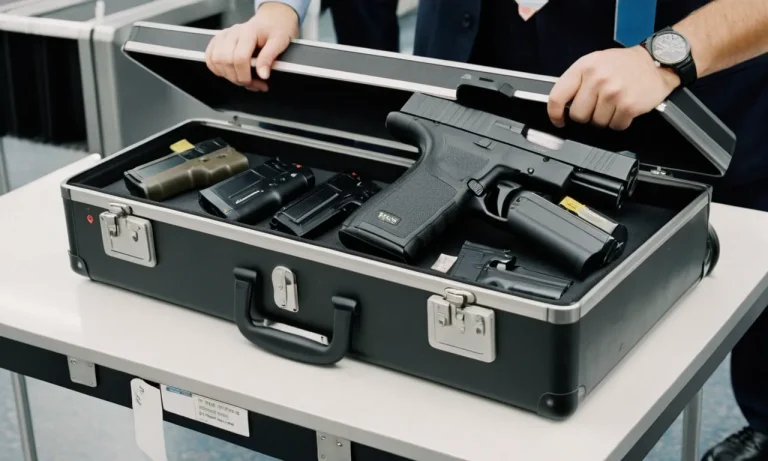Traveling internationally can be tricky when you’re trying to bring certain items with you.
One common question many travelers have is whether you can bring oils, like essential oils or cooking oils, in your carry-on or checked baggage when flying overseas.
If you’re short on time, here’s a quick answer to your question: Yes, you can bring small amounts of oil in your carry-on or checked bags on international flights. But there are some important rules and restrictions to be aware of.
TSA and Airline Rules for Flying with Oils
3-1-Ounce Rule for Carry-Ons
When it comes to bringing oil on an international flight, it is important to understand the rules set by the Transportation Security Administration (TSA) and the airlines.
The TSA follows the 3-1-1 rule for carry-on liquids, which means that any liquid, including oils, must be in containers that are 3.4 ounces (100 milliliters) or less.
These containers should be placed in a clear, quart-sized plastic bag. Each passenger is allowed only one bag.
It is important to note that this rule applies to all liquids, including oils. Therefore, if you plan to bring oil on an international flight, make sure to transfer it into a small, travel-sized container that meets the TSA requirements.
Quart-Sized Bags for Liquids
The quart-sized bag for liquids is an essential part of complying with the TSA regulations. This bag should be easily accessible and separate from other items in your carry-on luggage.
It helps the TSA officers to quickly inspect the liquids you are carrying, including oils.
Remember to place your oil containers in the quart-sized bag when going through the security checkpoint.
This will ensure a smoother and faster screening process, allowing you to proceed with your travel plans without any hassle.
Checking Larger Amounts
If you need to bring larger amounts of oil, exceeding the 3.4-ounce limit, it is recommended to pack them in your checked luggage.
However, it is important to check with your airline beforehand as they may have their own specific rules and restrictions for liquids in checked baggage.
Additionally, it is crucial to properly secure and pack the oil containers to prevent any leakage or damage to your luggage.
Placing the containers in sealed plastic bags or using leak-proof containers can help ensure that your oil arrives safely at your destination.
Types of Oils Allowed in Carry-on vs Checked Bags
When it comes to traveling with oils, whether it’s for personal use or as a gift, it’s important to know the regulations and restrictions set by airlines.
Different types of oils have different rules regarding their transportation on international flights. Here are the types of oils allowed in carry-on bags and checked bags:
Essential Oils
Essential oils have gained popularity in recent years for their various therapeutic benefits. These oils, derived from plants, are typically packed in small bottles and used for aromatherapy, skincare, and other purposes.
The Transportation Security Administration (TSA) allows passengers to bring essential oils in their carry-on bags as long as they comply with the liquid restrictions (usually no more than 3.4 ounces or 100 milliliters per container).
It’s important to pack them in a clear, quart-sized bag and present them separately during the security screening process.
Cooking Oils
If you’re planning to bring cooking oils on your international flight, it’s essential to check the airline’s regulations beforehand.
In general, small quantities of cooking oils are allowed in carry-on bags, provided they comply with the liquid restrictions.
However, it’s worth noting that some airlines may have specific rules or restrictions, so it’s always a good idea to check their official website or contact them directly for clarification.
Motor Oils and Fuels
When it comes to motor oils and fuels, they are not allowed in either carry-on or checked bags due to safety reasons.
These substances are considered hazardous materials and can pose a risk during transportation.
If you need to bring motor oils or fuels for a specific purpose, it’s recommended to contact the airline in advance to explore alternative options or make the necessary arrangements to transport them safely.
It’s important to remember that airline regulations can change, so it’s always a good idea to double-check with the airline before your trip.
Additionally, keeping oils properly sealed and packed securely can help prevent any leakage or damage to your belongings during the flight.

Packing Tips for Transporting Oils Safely
When it comes to packing oils for an international flight, it is important to follow certain guidelines to ensure the safety of yourself and others. Here are some packing tips to consider:
Use Leak-Proof Containers
One of the most important aspects of packing oils for travel is to use leak-proof containers. This is crucial to prevent any spills or leaks that could potentially damage other items in your luggage.
It is recommended to use containers specifically designed for transporting liquids, such as travel-sized bottles with tight-sealing caps.
These containers are readily available at most travel supply stores or online retailers.
Wrap with Absorbent Material
Another important tip when packing oils is to wrap the containers with absorbent material. This will provide an extra layer of protection in case of any leaks or spills.
You can use items such as paper towels or absorbent pads to wrap around the containers before placing them in your luggage.
This will help absorb any potential leaks and prevent them from spreading to other items in your bag.
Label Clearly
Properly labeling your oil containers is essential for both your own convenience and the safety of airport staff. Make sure to clearly label the containers with the type of oil they contain.
This will help airport security identify the contents of your luggage and handle it accordingly.
Additionally, if there are any specific instructions or warnings regarding the oil, such as flammability or temperature considerations, be sure to include them on the label as well.
It is important to note that each country has its own regulations regarding the transportation of liquids, including oils.
It is advisable to check with the airline or the country’s customs and transportation authorities for any specific restrictions or guidelines before packing oils for your international flight.
What Happens if You Break the Rules
Traveling internationally can be an exciting experience, but it’s important to familiarize yourself with the rules and regulations before boarding your flight.
One common question that arises is whether you can bring oil on an international flight. Let’s explore what happens if you break the rules.
Oils Over 3.4 Ounces Can Be Confiscated
When it comes to liquids, including oils, there are restrictions in place for international flights.
The Transportation Security Administration (TSA) has implemented a 3-1-1 rule, which means that each passenger can only bring liquids in containers that are 3.4 ounces (100 milliliters) or less.
If your oil exceeds this limit, it may be confiscated at the security checkpoint.
This rule is in place for security reasons, as larger quantities of liquids can potentially be used to create explosive devices. It’s important to follow these regulations to ensure the safety of all passengers on board.
To avoid having your oil confiscated, it’s best to transfer it into smaller containers that comply with the 3.4-ounce limit. This way, you can still bring your favorite oils with you on your travels.
You Could Face Additional Screening or Fees
If you attempt to bring oil that exceeds the allowed limit, you may face additional screening or fees. The TSA has the authority to conduct further inspections if they suspect that a passenger is carrying prohibited items.
This can lead to delays and inconvenience during the security screening process.
In addition, some airlines may have specific policies regarding the transportation of oils.
It’s important to check with your airline before your flight to understand their guidelines and any potential fees that may be associated with bringing oil on board.
Remember, breaking the rules can have consequences and may result in inconvenience or even financial penalties.
It’s always best to familiarize yourself with the regulations and comply with them to ensure a smooth and hassle-free travel experience.
Conclusion
When traveling internationally with oils, following TSA rules and airline policies is important to get through security screening and customs smoothly.
With some smart packing techniques, small amounts of oils can be transported safely in carry-on or checked luggage.
The key things to remember are to stick to 3.4 ounces or less per container for carry-ons, use secure leak-proof bottles, and check larger amounts in your hold baggage.
Knowing the specific regulations can help ensure your next international flight goes off without a hitch!






